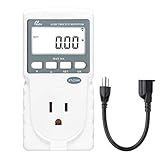In this article, I discuss the electricity usage of portable air conditioners, specifically, their Power Usage (measured in Watts), their Energy Consumption (measured in kWh), and their Amp Draw (measured in Amps).
Whether you’re trying to size equipment that’ll run your portable AC, such as solar panels, batteries, an inverter, or a generator, or simply are trying to figure out the cost of running the portable unit, this article will provide all the information you need.
Let’s get into it.
I get commissions for purchases made through links in this post.
How many watts (Power) does a portable AC use?
The power consumption of a portable air conditioner, often referred to as its “Wattage”, is primarily determined by its cooling capacity, typically measured in BTUs (British Thermal Units).
The BTU rating of a portable AC unit reflects its heat exchange performance, the greater the BTU rating, the greater the rate at which the AC performs heat exchange, and naturally, the more power (Watts) it will require to operate.
For a quick reference, here’s a table that provides an approximate wattage range for portable air conditioners based on their BTU ratings:
| BTU rating (ASHRAE) | BTU rating (SACC/DOE) | Est. Power Usage (Watts) |
| 8000 BTUs | 4000 – 6000 BTUs | 750 – 1000 Watts |
| 10000 BTUs | 6000 – 8000 BTUs | 950 – 1300 Watts |
| 12000 BTUs | 7000 – 10000 BTUs | 1100 – 1500 Watts |
| 14000 BTUs | 8000 – 11000 BTUs | 1300 – 1700 Watts |
To determine the power consumption of your portable AC unit, refer to the nameplate, usually attached to the side of the air conditioner. This nameplate contains various electrical specifications, including the power rating of the unit, expressed in watts (W).
On the nameplate, keep an eye out for the power usage in Watts (W), usually indicated as “Power”, “Power Usage”, “Power Rating”, “Rated Input”, “Power Consumption”, “Wattage”, or simply “Watts”.
For example, let’s take a look at this nameplate from a 12000 BTU (1 ton) portable air conditioner:
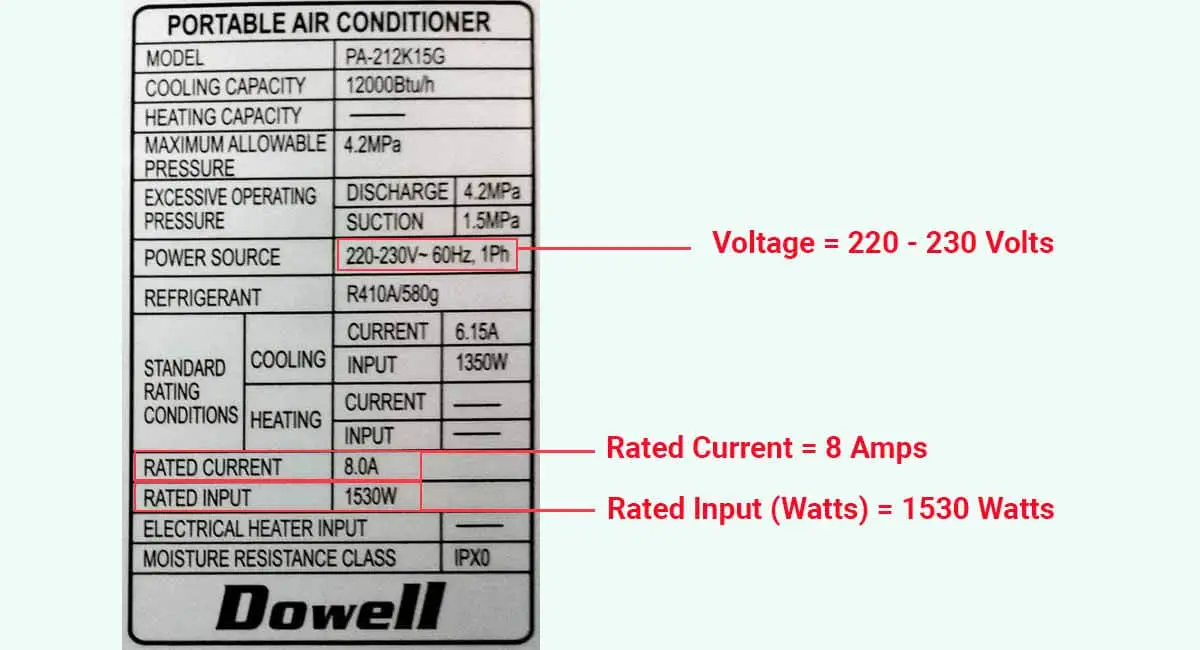
On the nameplate, the manufacturer specifies a “Rated Input” of 1530 Watts. This rating represents the maximum amount of power that the portable unit may require during normal operation.
Additionally, the nameplate mentions a “Rated Current” of 8 Amps and a Voltage range of 220 to 230 Volts.
When the Wattage isn’t directly listed on the nameplate, you can calculate it using the Amp rating (Amperage) and Voltage:
Rated Wattage = Rated Amperage x Voltage x 0.85
For example, if we assume a median Voltage of 225 Volts, the Wattage of this particular unit can be calculated as follows:
Rated Wattage = Rated Amperage x Voltage x 0.85
Rated Wattage = 8 Amps x 225 Volts x 0.85
Rated Wattage = 1530 Watts
Now, what we’ve just discussed is the power usage of the air conditioner, measured in Watts, which should not be confused with its energy consumption, measured in Watts-hours, or more commonly, kiloWatt-hours (kWh).
Learn more here: What is the difference between Watts and kilowatt-hours (kWh)?
Understanding the power usage of an air conditioner becomes especially important when you’re considering the equipment needed to operate it, like an inverter or a generator.
However, if you’re trying to gauge the actual quantity of electricity that the portable AC consumes and the costs associated with that, your primary focus should be kWh usage.
Let’s see what the energy consumption of portable air conditioners looks like.
How much electricity (kWh) does a portable AC use?
The exact energy consumption of an air conditioner depends on a few factors, such as:
- The outdoor temperature.
- The indoor temperature setting.
- The quality of insulation in the room.
- The capacity of the air conditioner.
- The energy efficiency of the air conditioner.
- And the usage patterns of the AC.
For instance, an 8000 BTU portable AC may typically use around 0.8 kWh of energy per hour when running. In contrast, a 14000 BTU portable air conditioner can consume up to 1.6 kWh of energy per hour.
However, the energy usage of another 14000 BTU portable AC operating under different conditions, with higher energy efficiency, might be as low as 1.1 kWh per hour.
To simplify, we can estimate the hourly energy consumption of portable air conditioners based on their cooling capacity (BTUs) and efficiency ratings, even if we don’t account for all the operational variables.
Before I get into that, to give you an initial perspective, let’s start with a table that categorizes portable air conditioners by their BTU ratings and provides an approximate hourly energy consumption in kWh.:
| BTU rating (ASHRAE) | BTU rating (SACC/DOE) | Est. Hourly Energy Consumption (kWh/hour) | Est. Daily Energy Consumption (kWh/day) assuming 8 hours of daily operation |
| 8000 BTUs | 4000 – 6000 BTUs | 0.7 – 0.9 kWh/hour | 5.5 – 7.5 kWh/day |
| 10000 BTUs | 6000 – 8000 BTUs | 0.85 – 1.1 kWh/hour | 7 – 9 kWh/day |
| 12000 BTUs | 7000 – 10000 BTUs | 1 – 1.3 kWh/hour | 8 – 10.5 kWh/day |
| 14000 BTUs | 8000 – 11000 BTUs | 1.2 – 1.5 kWh/hour | 9.5 – 12 kWh/day |
The table presents two distinct BTU ratings for portable air conditioners:
- ASHRAE BTU Rating
- SACC or DOE BTU Rating
These ratings both measure the cooling capacity of portable air conditioners, differing only in the testing conditions employed to determine the BTU rating.
The ASHRAE BTU rating is the older standard and is still the one manufacturers typically use to indicate their portable air conditioner’s capacity initially. This preference is understandable because the newer SACC or DOE BTU rating tends to be approximately 30% to 50% lower due to the specific testing procedures.
Generally, if a manufacturer doesn’t explicitly state whether a BTU rating is ASHRAE or SACC (DOE), it’s safest to assume it’s the ASHRAE rating.
In addition to the BTU rating, manufacturers also specify an energy efficiency rating, which reflects how efficiently the air conditioner uses electrical energy for heat exchange. For portable air conditioners, this energy efficiency rating is often expressed as CEER (Combined Energy Efficiency Ratio).
The relationship between your air conditioner’s heat exchange capacity (BTUs), energy consumption (kWh), and CEER rating can be expressed as follows:
Hourly Energy Consumption (Watt-hours per hour) = SACC (DOE) BTU rating ÷ CEER
For instance, consider the following EnergyGuide label that comes with the Midea 8000 BTU (ASHRAE) portable air conditioner:
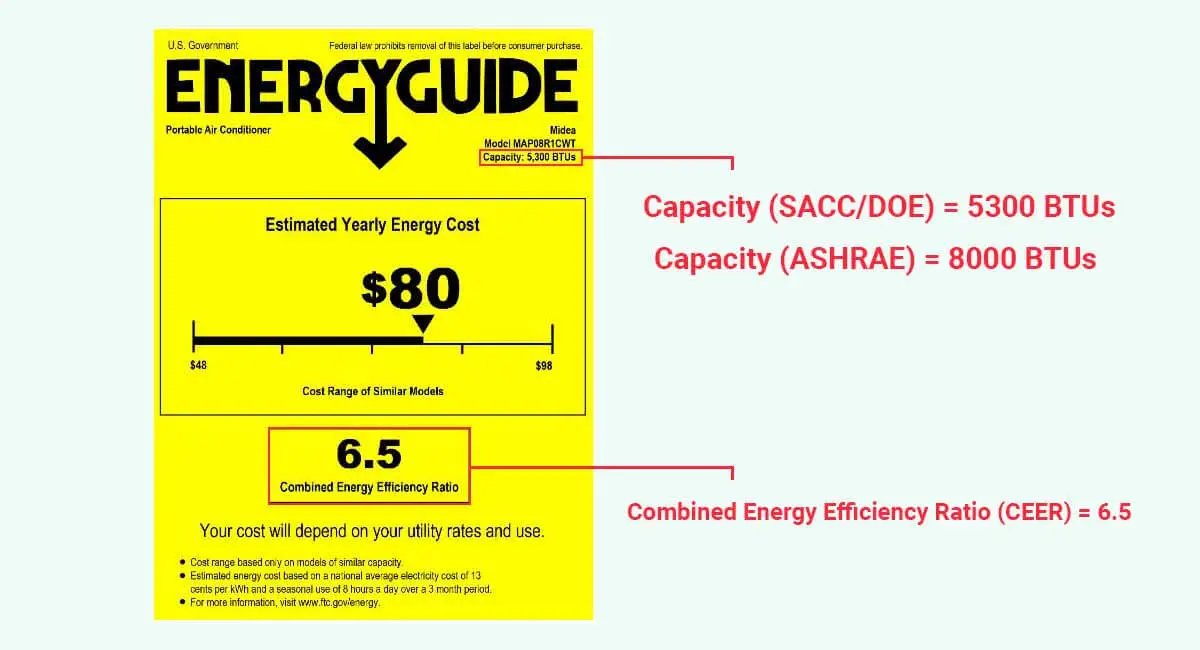
This 8000 BTU portable AC has a SACC rating of 5300 BTUs, and a CEER rating of 6.5. Using our formula, we can calculate the hourly energy consumption of this portable AC:
Hourly Energy Consumption (Watt-hours per hour) = SACC (DOE) BTU rating ÷ CEER
Hourly Energy Consumption (Watt-hours per hour) = 5300 BTUs ÷ 6.5
Hourly Energy Consumption (Watt-hours per hour) = 815 Wh/hour
To convert this into kiloWatt-hours per hour (kWh/hour), we’ll simply divide by 1000:
Hourly Energy Consumption (kiloWatt-hours per hour) = Hourly Energy Consumption (Watt-hours per hour) ÷ 1000
Hourly Energy Consumption (kiloWatt-hours per hour) = 815 ÷ 1000
Hourly Energy Consumption (kiloWatt-hours per hour) = 0.81 kWh/hour
According to the manufacturer’s specifications, this specific portable air conditioner typically consumes about 0.81 kWh of energy per hour of operation, on average.
You can use this hourly energy consumption in conjunction with the number of hours you run the air conditioner each day to estimate your daily and monthly energy usage.
By following this approach, you can gain a reasonable understanding of the energy consumption you can anticipate from the portable air conditioner. However, for the most precise measurements, I would recommend utilizing an energy consumption monitor
A device such as the P3 P4400 Kill-A-Watt or the Poniie PN200 can measure different aspects of your air conditioner’s electricity usage, including its energy consumption over a certain period.
For instance, if you use the Kill-A-Watt meter, the process is simple. Just plug the device between your air conditioner and the electrical outlet, then press the purple button labeled “kWh”.
Keep the air conditioner ON for the desired timeframe you wish to measure energy consumption, and the Kill-A-Watt meter will provide accurate measurements.
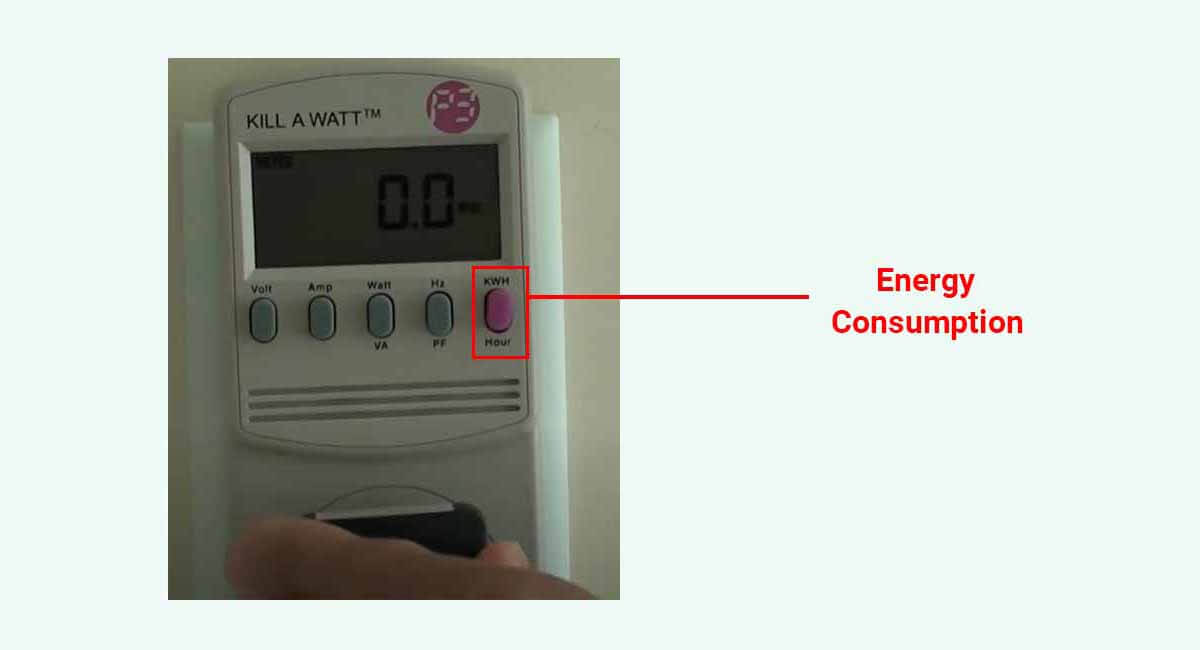
Aside from equipment sizing, the energy consumption of your portable air conditioner can also be used to estimate the costs of running the unit.
Speaking of which, let’s discuss cost estimates.
How much does it cost to run a portable air conditioner?
The cost of running a portable air conditioner depends directly on its energy consumption (kWh), which means it also depends on factors such as the difference between outdoor and indoor temperature, quality of insulation, and efficiency of the air conditioner.
However, other than the energy consumption of the portable air conditioner, the cost of running the AC will also depend on the electricity costs in your area.
For example, in some areas of the U.S., electricity providers charge as little as 11 Cents per kWh of electricity, while in other areas, 1 kWh of energy might cost up to 30 cents.
However, to provide some perspective, the following table uses the national average cost per kWh in the U.S. of 16 cents/kWh to estimate the hourly cost of running portable air conditioners based on their ASHRAE BTU ratings:
| BTU rating (ASHRAE) | Est. Hourly Cost (cents) to run the AC |
| 8000 BTUs | 12 – 15 cents/hour |
| 10000 BTUs | 13 – 18 cents/hour |
| 12000 BTUs | 16 – 21 cents/hour |
| 14000 BTUs | 20 – 24 cents/hour |
If you have an estimate of the energy consumption of your portable AC, or preferably a measurement, you can combine it with the cost per kWh in your area to calculate your own cost estimates:
Cost of running the portable AC ($) = Energy Consumption (kWh) x Cost per kWh ($/kWh)
For instance, let’s say we want to determine the monthly cost to run a 14000 BTU portable AC, and let’s make the following assumptions:
- The air conditioner – on average – uses 1.3 kWh of energy per hour of operation
- The air conditioner typically runs for 8 hours a day
- The air conditioner is located somewhere in the state of Texas
First, we calculate the average monthly energy consumption of our air conditioner:
Monthly Energy Consumption (kWh/month) = Hourly Energy Consumption (kWh) x 8 hours/day x 30 days/month
Monthly Energy Consumption (kWh/month) = 1.3 kWh x 8 hours/day x 30 days/month
Monthly Energy Consumption (kWh/month) = 312 kWh/month
Now, all we need is the cost per kWh in the area, and a quick way to get an estimate, is to refer to this table from the Energy Information Agency (EIA).
According to the EIA, the average cost per kWh in Texas is around 14.5 cents per kWh ($0.145/kWh). Using this piece of information, we can calculate the monthly cost of running our air conditioner:
Monthly Cost of running the portable AC ($) = Energy Consumption (kWh/month) x Cost per kWh ($/kWh)
Monthly Cost of running the portable AC ($) = 312 kWh/month x $0.145/kWh
Monthly Cost of running the portable AC ($) = $45.24/month
To save you some time, I’ve put together a calculator that estimates the daily and monthly cost of running your portable AC based on its BTU rating (ASHRAE), its average daily usage duration (in hours), and the average cost per kWh in your location:
How many amps does a portable AC use?
The exact amperage rating of a portable air conditioner depends not only on its cooling capacity (BTUs) but also on the efficiency of the unit.
To give you an initial overview, here’s a table that classifies portable AC units by their ASHRAE BTU ratings and estimates their amperage ratings (Amps):
| BTU rating (ASHRAE) | Est. Amperage rating (Amps) |
| 8000 BTUs | 6.5 – 8.5 Amps |
| 10000 BTUs | 8 – 10.5 Amps |
| 12000 BTUs | 9.5 – 12 Amps |
| 14000 BTUs | 11.5 – 14 Amps |
Please note that these estimates are based on the assumption that these portable air conditioners operate on 110-120 Volts, which is the typical household voltage in the U.S.
For air conditioners that use 220-240 Volts, the amperage ratings would be half of the values provided in the table.
Speaking of Voltage, a good way to determine the amperage rating of your portable air conditioner is to divide the Power rating of the AC by its Voltage rating:
Amperage (Amps) = Power Usage (Watts) ÷ Voltage (Volts)
For example, if we take a second look at the nameplate used in our previous example, from a 10000 BTU portable AC, we’ll see a rated power usage of 950 Watts and a Voltage of 115 Volts:
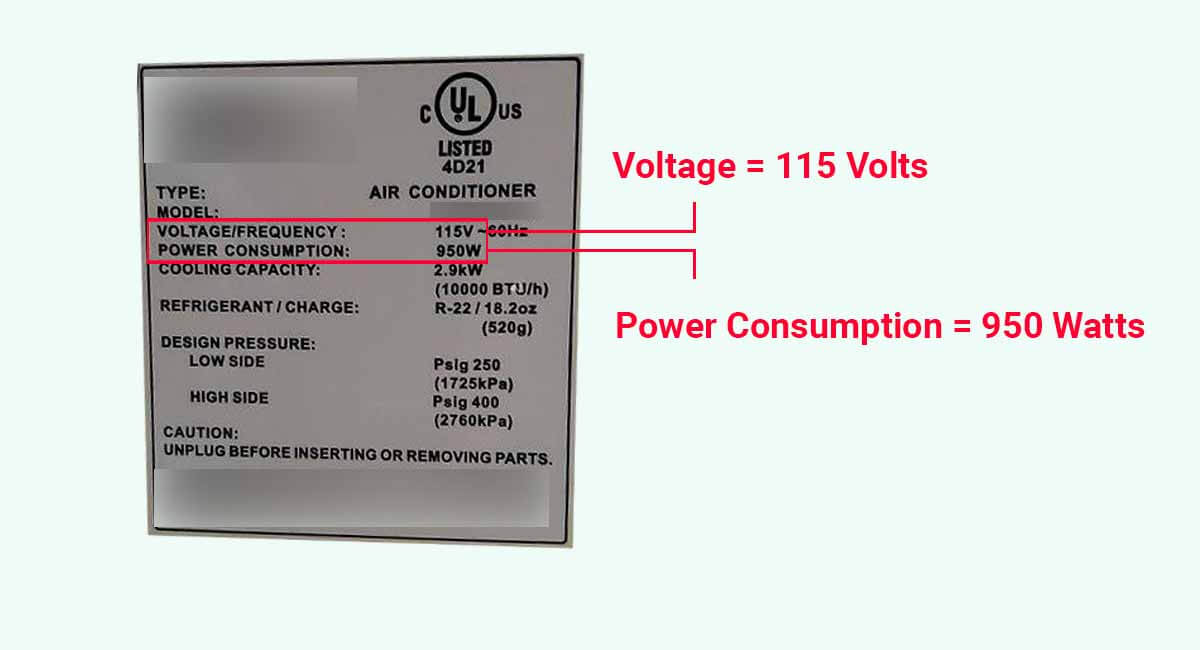
Since the amperage of this air conditioner is not directly specified, we can use the wattage and voltage to calculate it:
Amperage (Amps) = Power Usage (Watts) ÷ Voltage (Volts)
Amperage (Amps) = 950 Watts ÷ 115 Volts
Amperage (Amps) = 8.26 Amps






